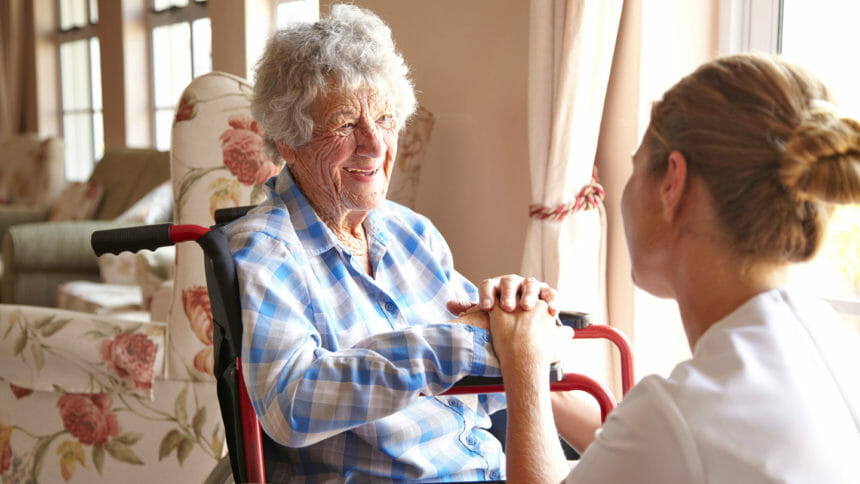
Sound practices in diabetic wound management go a long way toward controlling and healing existing wounds — and preventing new ones. Although dressings are an important focal point, experts emphasize this field of care involves a lot more. Here’s how.
1 – Diabetic wound care starts with a thorough assessment.
The “60-second foot exam for people with diabetes,” developed by Shane Inlow, M.D., is recommended by Margaret Falconio-West, RN, senior vice president, clinical services, Advanced Wound Care Division, Medline Industries.
It’s easy and “validated with the very population that we are trying to help,” she says.
Peripheral neuropathy — a nerve-damaging condition related to poor circulation — can mask wound development because patients often don’t complain of underlying pain, says Billie Jo Schwerin, RN, director of clinical services at DermaRite Industries. That pain often results from repetitive stress injury from poorly fitting shoes.
“These wounds can be present for a while before the person even notices they have them,” adds Paula Erwin-Toth, RN, wound care clinical consultant, MediPurpose.
2 – Long after initial assessments, it’s critical to remain vigilant with vulnerable or susceptible populations.
Impending wounds have warning signs if you know what to look for on a periodic basis, notes Jace Nelson, marketing and communications specialist, ARKRAY USA. Look for cracked or broken skin, unusually cold feet, as well as bumps or irregularities on the balls, sole and tops, and discolored or unusually thick toenails.
Erwin-Toth warns that poor circulation and trauma can increase the risk of a wound infection.
“These infections can be a challenge to treat, and impede the patient’s ability to heal,” she says, adding that ongoing proper nutrition and hydration, tobacco cessation, foot care and wound debridement (when there is adequate blood supply) will go a long way in preventing bigger problems.
3 – Diet is the best and most reliable method for wound care and prevention in diabetics, experts say. And it comes down to glucose.
“The most critical part of caring for a diabetic patient with a wound is stabilizing their blood glucose levels,” Erwin-Toth says. Complicating matters is that the very presence of a wound can make it even more difficult for a patient to keep their blood glucose levels in check, she adds. She advises caregivers keep the target range for patients’ plasma blood glucose before meals at 70-130 mg/dl and 7% hemoglobin A1C.
4 – Carefully choose the right dressing and protocol. Prepare the wound bed before applying a dressing or treatment, says Erwin-Toth.
“All wounds are contaminated, but diabetics with wounds are more apt to develop an adherent biofilm and/or a local or systemic wound infection,” she says. “Select a dressing that creates an environment for healing, and protects fragile periwound skin.”
It’s very important to be mindful of basic wound healing principles, advises Falconio-West.
“Consider products such as antimicrobial barrier dressings, smart dressings and even skin substitutes to manage the needs of the wound,” she adds.
An often overlooked consequence of tightly applied dressings is swelling that can occur hours later in patients who dangle their legs or feet while at rest, cautions Schwerin. Bordered dressings may work best as long as there is sufficient healthy intact tissue.
Ensure dressing removal, or “offloading,” is performed carefully and skillfully to avoid undue damage to a healing wound bed, adds Falconio-West.
5 – Finally, never forget the unique needs of the person you are treating.
“As with all wounds, it is vital the clinician treat the whole person, not the ‘hole’ in the person,” says Erwin-Toth. This includes constantly tweaking an individualized care plan as the patient and the wound changes. Patients need to be reminded improper wound care could cost them a foot or a leg.
“Sometimes it is simply understanding the process and disease management, as detailed as they are,” says Falconio-West. “Treating someone with diabetes is really a collaborative effort — not a dictatorship — by the person and the clinical team.”
Mistakes to avoid
Failing to perform thorough assessments that include peripheral neuropathy
Overlooking the “whole” patient, and unique needs and behaviors
Neglecting strict dietary requirements, as well as blood glucose monitoring
From the July 01, 2014 Issue of McKnight's Long-Term Care News




